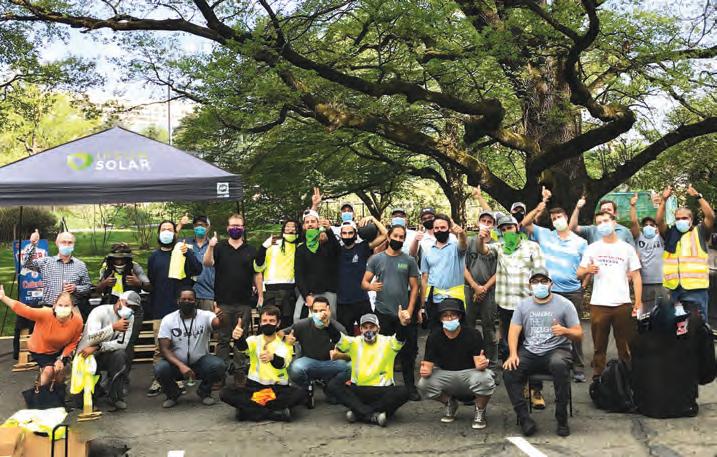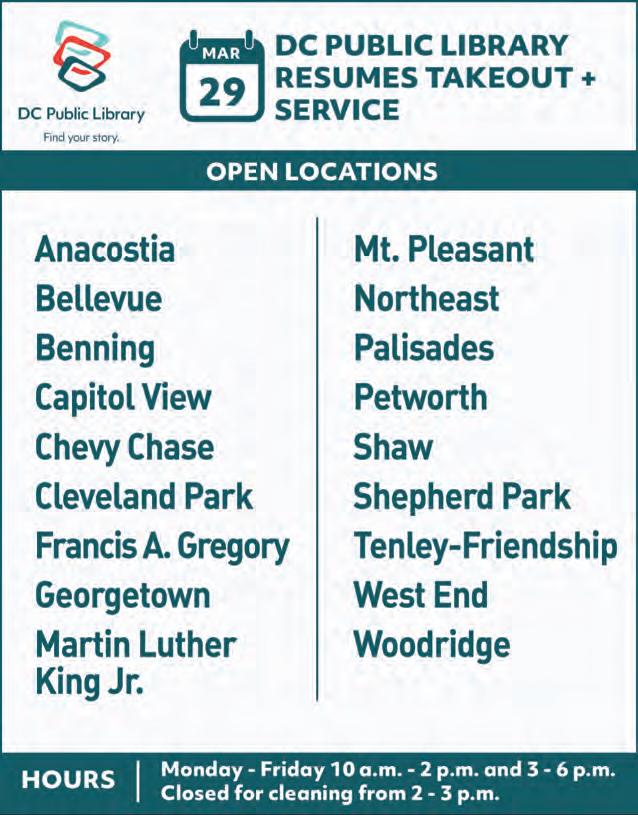
6 minute read
The Pennsylvania Avenue SE Small Area Plan: How You Can Get Involved by Elizabeth O’Gorek
The Pennsylvania Avenue SE Small Area Plan
How You Can Get Involved
What do you want the Pennsylvania Avenue Corridor on the east side of the Anacostia to look like in the next ve to ten years? What should be preserved, and what should change? What about development, or green space?
If you have ideas or opinions on these topics, you’ll want to get involved with the Pennsylvania Avenue SE Small Area Plan.
A Small Area Plan (SAP) is a neighborhood-speci c companion to the Comprehensive Plan. It adds additional details, recommendations and strategies for particular corridors and sites in the city.
The Pennsylvania Avenue SE SAP study area extends along Pennsylvania Avenue SE from the eastern landing of the Sousa Bridge to Southern Avenue and a quarter mile to the north and south of the corridor.
The O ce of Planning (OP) will take the lead in working with the community to develop a vision for a gateway corridor that is vibrant and meets the needs of adjacent neighborhoods.
While an SAP was already completed for Pennsylvania Avenue SE in 2008, this round builds on the ideas and turns toward implementation. The plan is also meant to further the city’s goals around racial and socioeconomic equity.
The plan will develop recommendations that can be implemented within a 10-year horizon to meet the following project goals: • Enhance a safe, accessible, vibrant public realm; • Encourage economic development and retail opportunities; • Improve transportation access and connectivity; and • Explore housing opportunities to improve access for upward mobility. • Opportunities in Pennsylvania East
The SAP is not the rst sign that the District is focusing on development in the area. The Pennsylvania Avenue East Corridor was designated a Main Street in July 2020. Main Streets is a comprehensive program that promotes the revitalization of business corridors.
Pennsylvania Avenue East Main Street (PAEMS) Director Latisha Atkins said the organization will work to revitalize the Pennsylvania Avenue SE corridor by retaining and recruiting businesses, improving commercial properties and streetscapes, and attracting consumers. The SAP is very important to those goals, she said.
“This plan will be vital in helping to address longstanding issues and concerns, such as better retail options while placing special attention on things like walkability, transportation and housing concerns,” Atkins said.
The plan will also factor in the needs of existing businesses. It will also create better access to the corridor as well as surrounding amenities and resources, Atkins said, and marketing e orts to attract development.
However, public participation in the SAP process is key to ensuring the voices of the residents and stakeholders are being heard, Atkins noted.
“Simply put, decisions are made by those who show up,” she said. “The community must actively participate in the process if it hopes to see change that will bene t the community and its residents.”
ANC 7B02 Commissioner Kelvin Brown agreed, saying the SAP is an opportunity for neighbors to advocate for changes they want to see over the next ve to 10 years. Brown said this is particularly important to communities in Ward 7 and 8, who often do not receive the same resources as the rest of the city.
“The plan puts into motion what is to be done as far as amenities, neighborhood improvements to infrastructure and other social services and bene ts that are needed by our community,” Brown said.
Brown, whose SMD borders the corridor, said he knows what he’d like to see included: participatory economic development, including grants and loans that can help build generational wealth; an equitable transportation access plan; and state-of-the-art public facilities, such as schools, libraries and recreation centers.
“It’s an opportunity [for neighbors] to ensure we have a collective part in the wave of economic prosperity [and the] updates to amenities, transportation and infrastructure that’s coming and is going to impact our lives east of the river,” Brown said.

by Elizabeth O’Gorek
The Pennsylvania Avenue East Corridor is the subject of the latest Small Area Plan (SAP) from the DC Of ce of Planning (OP).
Southwest Experience
Residents of other neighborhoods have already seen the impact of that development and the useful role an SAP can play. After 18 months of work, DC Council approved the Southwest SAP in 2015.
In the wake of signi cant development nearby, including the Wharf and Nationals Park, neighbors realized that they could be “steamrolled” by developers without some sort of guidance, said Advisory Neighborhood Commissioner (ANC) Andy Litsky (6D04).
That revelation was triggered by a 2013 e ort to develop a high school on the recreation space now known as Ryan Zimmerman Field. Now a brand-new recreational facility, at the time it was a less well-maintained green space that was nonetheless widely used by people throughout the city.
“There was the recognition that if we didn’t step up as a community, we would wind up losing small chunks —and then larger chunks— to unbridled development,” Litsky said.
Litsky said an SAP was key to de ning the way that
the community wanted to be perceived, and how they want it to grow. The Southwest community included green space, retail and transportation as key elements of their SAP, but really prioritized the creation and preservation of a ordable housing. One goal was that nobody would be forced from their homes due to development, and that goal was met, Litsky said. The SAP does not only help communities work through matters of development. Southwest Business Improvement District (SWBID) Executive Director Stephen Moore said the SAP process and plan were key in identifying big issues and local opportunities in the area. The Southwest SAP provided the starting point for creating the SW Farmer’s Market, as well as renovations to the Duck Pond, the site of the BID’s August Sunday Suppers. “It opened up a real kind of agenda for us,” Moore said.
How to Participate
The public kick-o meeting for the Pennsylvania Avenue East SAP will take place on Wednesday, April 14 at 6 p.m. The virtual meeting will be broadcast online at publicinput.com/PennAveSEPlan.
If you are unable to join online, you can dial-in at: 855-925-2801 (pin: 9252).
The April 14 meeting will answer questions that include: • what is a Small Area Plan and the role it plays in the future of the Pennsylvania
Avenue East Corridor • the topics and goals that are the focus of the Pennsylvania Avenue East SAP.
Attendees will also have the opportunity to discuss the project with the OP project team.
But OP said that the public kick-o is just one of many opportunities to learn more and stay engaged in the planning process. Throughout the process, community members and stakeholders will have the opportunity to provide critical feedback through survey questions, discussions with the project team, and participation in community meetings.
Get involved today by visiting: publicinput.com/PennAveSEPlan. Take the survey at https://www.publicinput.com/pennaveseplan. Questions? Reach out online at PennAveSEplan@dc.gov or on the phone at 855-925-2801 (pin: 9252). ◆

GET YOUR BEANS DELIVERED
660 Pennsylvania Ave SE 1718 14th St. NW Order With Union Market Joe’s Coffee App www.peregrineespresso.com JOE.COFFEE






